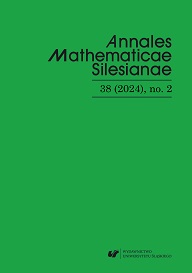A. Behera and G.K. Panda, On the square roots of triangular numbers, Fibonacci Quart. 37 (1999), no. 2, 98–105.
Google Scholar
F. Bezerra, F. Alves, and R. Vieira, Relações recorrentes bidimensionais e tridimensionais de Narayana, C.Q.D. – Revista Eletrónica Paulista de Matemática 18 (2020), Ediçaõ Iniciaçaõ Cientifica Julho, 12–28.
Google Scholar
S. Bouroubi, On the square-triangular and balancing-numbers, Rostock. Math. Kolloq. 72 (2019/20), 73–80.
Google Scholar
P. Catarino and A. Borges, On Leonardo numbers, Acta Math. Univ. Comenian. (N.S.) 89 (2019), no. 1, 75–86.
Google Scholar
P. Catarino, H. Campos, and P. Vasco, On some identities for balancing and cobalancing numbers, Ann. Math. Inform. 45 (2015), 11–24.
Google Scholar
P. Catarino and P. Vasco, The generalized order-m(k-Pell) numbers, An. Stiinµ. Univ. Al. I. Cuza Iaşi. Mat. (N.S.) 66 (2020), no. 1, 55–65.
Google Scholar
J. Chimpanzo, P. Catarino, P. Vasco, and A. Borges, Bidimensional extensions of balancing and Lucas-balancing numbers, J. Discrete Math. Sci. Cryptogr. Accepted.
Google Scholar
G.K. Gözeri, A. Özkoç, and A. Tekcan, Some algebraic relations on balancing numbers, Util. Math. 103 (2017), 217–236.
Google Scholar
R. Keskin and O. Karaatlı, Some new properties of balancing numbers and square triangular numbers, J. Integer Seq. 15 (2012), no. 1, Article 12.1.4, 13 pp.
Google Scholar
C. Kızılateş, A new generalization of Fibonacci hybrid and Lucas hybrid numbers, Chaos Solitons Fractals 130 (2020), 109449, 5 pp.
Google Scholar
K. Liptai, Fibonacci balancing numbers, Fibonacci Quart. 42 (2004), no. 4, 330–340.
Google Scholar
K. Liptai, Lucas balancing numbers, Acta Math. Univ. Ostrav. 14 (2006), no. 1, 43–47.
Google Scholar
K. Liptai, F. Luca, Á. Pintér, and L. Szalay, Generalized balancing numbers, Indag. Math. (N.S.) 20 (2009), no. 1, 87–100.
Google Scholar
P. Olajos, Properties of balancing, cobalancing and generalized balancing numbers, Ann. Math. Inform. 37 (2010), 125–138.
Google Scholar
R. Oliveira and F. Alves, Os números Gaussianos de Fibonacci e relações recorrentes bidimensionais, Revista Thema 16 (2019), no. 4, 745–754.
Google Scholar
R. Oliveira, F. Alves, and R. Paiva, Identidades bi e tridimensionais para os números de Fibonacci na forma complexa, C.Q.D. – Revista Eletrónica Paulista de Matemática 11 (2017), Dezembro 2017, 91–106.
Google Scholar
G.K. Panda and P.K. Ray, Cobalancing numbers and cobalancers, Int. J. Math. Math. Sci. 2005 (2005), no. 8, 1189–1200.
Google Scholar
G.K. Panda and P.K. Ray, Some links of balancing and cobalancing numbers with Pell and associated Pell numbers, Bull. Inst. Math. Acad. Sin. (N.S.) 6 (2011), no. 1, 41–72.
Google Scholar
P.K. Ray, Balancing and Cobalancing Numbers, Ph.D. Thesis, Department of Mathematics, National Institute of Technology, Rourkela, India, 2009.
Google Scholar
P.K. Ray, On the properties of k-balancing numbers, Ain Shams Engineering Journal 9 (2018), no. 3, 395–402.
Google Scholar
N.J.A. Sloane, The On-Line Encyclopedia of Integer Sequences. Available at OEIS
Google Scholar
R. Vieira, F. Alves, and P. Catarino, Relações bidimensionais e identidades da sequência de Leonardo, Revista Sergipana de Matemática e Educação Matemática 4 (2019), no. 2, 156–173.
Google Scholar



 10.2478/amsil
10.2478/amsil